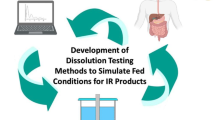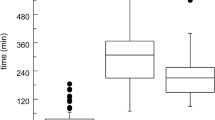Abstract
Simulation of gastrointestinal conditions is essential to adequately predict the in vivo behavior of drug formulations. To reduce the size and number of human studies required to identify a drug product with appropriate performance in both the fed and fasted states, it is advantageous to be able to pre-screen formulations in vitro. The choice of appropriate media for such in vitro tests is crucial to their ability to correctly forecast the food effect in pharmacokinetic studies. The present paper gives an overview of the development and composition of biorelevant dissolution media that can be used for the in vitro simulation of different dosing conditions (fasted and fed states). In addition, the application of these media to predicting food effects is described in several case examples.




Similar content being viewed by others
References
Dressman JB, Reppas C. In vitro–in vivo correlations for lipophilic, poorly water-soluble drugs. Eur J Pharm Sci. 2000;11 Suppl 2:73–80.
Noyes AA, Whitney WR. The rate of solution of solid substances in their own solutions. J Am Chem Soc. 1897;19:930–4.
Nernst W. Theorie der Reaktionsgeschwindigkeit in heterogenen Systemen. Z Physikal Chemie. 1904;47:52–5.
Horter D, Dressman JB. Influence of physicochemical properties on dissolution of drugs in the gastrointestinal tract. Adv Drug Del Rev. 1997;25(April):3–14.
Dressman JB, Amidon GL, Reppas C, Shah VP. Dissolution testing as a prognostic tool for oral drug absorption: immediate release dosage forms. Pharm Res. 1998;15(1):11–22.
Ozturk SS, Palsson BO, Dressman JB. Dissolution of ionizable drugs in buffered and unbuffered solutions. Pharm Res. 1988;5(5):272–82.
Shah VP. Dissolution: a quality control test vs a bioequivalence test. Dissolution Technologies. 2001;8(4):6–7.
FDA. Guidance for industry: dissolution testing of immediate release solid oral dosage forms. Rockville MD, USA: U.S. Department of Health and Human Services, Food and Drug Administration, Center for Drug Evaluation and Research (CDER); 1997.
FDA. Guidance for industry: extended release oral dosage forms: development, evaluation, and application of in vitro/in vivo correlations. Rockville MD, USA: US Department of Health and Human Services, Food and Drug Administration, Center for Drug Evaluation and Research (CDER); 1997.
FDA. Guidance for industry: waiver of in vivo bioavailability and bioequivalence studies for immediate-release solid oral dosage forms based on a biopharmaceutics classification system. Rockville MD, USA: US Department of Health and Human Services, Food and Drug Administration, Center for Drug Evaluation and Research (CDER); 2000.
Dressman JB, Berardi RR, Dermentzoglou LC, Russell TL, Schmaltz SP, Barnett JL, et al. Upper gastrointestinal (GI) pH in young, healthy men and women. Pharm Res. 1990;7(7):756–61.
Efentakis M, Dressman JB. Gastric juice as a dissolution medium: surface tension and pH. Eur J Drug Metab Pharmacokinet. 1998;23(2):97–102.
Finholt P, Solvang S. Dissolution kinetics of drugs in human gastric juice—the role of surface tension. J Pharm Sci. 1968;57(8):1322–6.
Finholt P, Gundersen H, Smit A, Petersen H. Surface tension of human gastric juice. Medd Norsk Farm Selsk. 1978;41:1–14.
Youngberg CA, Berardi RR, Howatt WF, Hyneck ML, Amidon GL, Meyer JH, et al. Comparison of gastrointestinal pH in cystic fibrosis and healthy subjects. Dig Dis Sci. 1987;32:472–80.
USP. USP 24. Rockville MD: United States Pharmacopeia Convention, Inc.; 2002.
Gray VA, Dressman J. Change of pH requirements for simulated intestinal fluid TS. Pharmacopeial Forum. 1996;22(1):1943–5.
Klein S, Reppas C, Dressman JB. In vitro methods to predict food effects. In: Amidon G, Lesko L, Midha K, Shah V, Hilfinger J, editors. International bioequivalence standards: a new era. Ann Arbor: TSRL Inc.; 2006.
Galia E, Horton J, Dressman JB. Albendazole generics—a comparative in vitro study. Pharm Res. 1999;16(12):1871–5 (in process citation).
Luner PE, VanDer Kamp D. Wetting characteristics of media emulating gastric fluids. Int J Pharm. 2001;212:81–91.
Vertzoni M, Pastelli E, Psachoulias D, Kalantzi L, Reppas C. Estimation of intragastric solubility of drugs: in what medium? Pharm Res. 2007;24(5):909–17.
Vertzoni M, Dressman J, Butler J, Hempenstall J, Reppas C. Simulation of fasting gastric conditions and its importance for the in vivo dissolution of lipophilic compounds. Eur J Pharm Biopharm. 2005;60(3):413–7.
Klein S. The mini paddle apparatus—a useful tool in the early developmental stage? Experiences with immediate release dosage forms. Dissolution Technologies. 2006;13(4):6–11.
Klein S, Shah V. A standardized mini paddle apparatus as an alternative to the standard paddle. Aaps Pharmscitech. 2008;9(4):1179–84.
Greenwood D. Small intestinal pH and buffer capacity: implications for dissolution of ionizable compounds. Doctoral thesis, University of Michigan, Ann Arbor; 1994
Galia E, Nicolaides E, Horter D, Lobenberg R, Reppas C, Dressman JB. Evaluation of various dissolution media for predicting in vivo performance of class I and II drugs. Pharm Res. 1998;15(5):698–705.
Hofmann AF, Small DM. Detergent properties of bile salts: correlation with physiological function. Annu Rev Med. 1967;18:333–76.
Carey MC, Small DM. Micelle formation by bile salts. Physical–chemical and thermodynamic considerations. Arch Intern Med. 1972;130(4):506–27.
Redinger RN, Small DM. Bile composition, bile salt metabolism and gallstones. Arch Intern Med. 1972;130(4):618–30.
Galia E. Physiologically based dissolution tests. Doctoral thesis, Johann Wolfgang Goethe University, Frankfurt; 1999.
Marques M. Dissolution media simulating fasted and fed states. Dissolution Technologies. 2004;11(2):16.
Ashby LJ, Beezer AE, Buckton G. In vitro dissolution testing of oral controlled release preparations in the presence of artificial foodstuffs. I. Exploration of alternative methodology: microcalorimetry. Int J Pharm. 1989;51:245–51.
Buckton G, Beezer AE, Chatham SM, Patel KK. In vitro dissolution testing of oral controlled release preparations in the presence of artificial foodstuffs. II. Probing drug/food interactions using microcalorimetry. Int J Pharm. 1989;56:151–7.
Kraemer J. Korrelation biopharmazeutischer in vivo und in vitro Daten von Theophyllin und Verapamil Retardpräparaten. Doctoral thesis, Ruprecht-Karls-Universität, Heidelberg; 1995
Ross. The Ross medical nutritional system. Product Handbook. Columbus, USA; 1993.
Junginger HE, Verhoeven J, Peschier LJC. A new in vitro model to detect interactions between controlled release dosage forms and food. Acta Pharm Technol. 1990;36(3):155–60.
FDA. Guidance for industry: food-effect bioavailability and bioequivalence studies. In: Draft guidance. Rockville MD, USA: US Department of Health and Human Services, Food and Drug Administration, Center for Drug Evaluation and Research (CDER); 1997.
Klein S, Butler J, Hempenstall JM, Reppas C, Dressman JB. Media to simulate the postprandial stomach. I. Matching the physicochemical characteristics of standard breakfasts. J Pharm Pharmacol. 2004;56(5):605–10.
Macheras P, Koupparis M, Tsaprounis C. Drug dissolution studies in milk using the automated flow injection serial dynamic dialysis technique. Int J Pharm. 1986;33:125–36.
Macheras P, Koupparis M, Apostolelli E. Dissolution of 4 controlled-release theophylline formulations in milk. Int J Pharm. 1987;36:3–79.
Macheras P, Koupparis M, Antimisaris S. An in vitro model for exploring CR theophylline–milk fat interactions. Int J Pharm. 1989;54:123–30.
Klein S. Biorelevant dissolution test methods for modified release dosage forms. Frankfurt: Shaker; 2005.
Fordtran JS, Locklear TW. Ionic constituents and osmolality of gastric and small-intestinal fluids after eating. Am J Dig Dis. 1966;11(7):503–21.
Klein S, Stippler E, Wunderlich M, Dressman J. Development of dissolution tests on the basis of gastrointestinal physiology. In: Dressman J, Kraemer J, editors. Pharmaceutical dissolution testing. Boca Raton: Taylor & Francis; 2005. p. 193–228.
Amidon GL, Lennernas H, Shah VP, Crison JR. A theoretical basis for a biopharmaceutic drug classification: the correlation of in vitro drug product dissolution and in vivo bioavailability. Pharm Res. 1995;12(3):413–20.
Stegemann S, Leveiller F, Franchi D, de Jong H, Linden H. When poor solubility becomes an issue: from early stage to proof of concept. Eur J Pharm Sci. 2007;31(5):249–61.
Stippler E. Biorelevant dissolution test methods to asses bioequivalence of drug products. Doctoral thesis, Johann Wolfgang Goethe University, Frankfurt; 2004
WHO. Proposal to waive in vivo bioequivalence requirements for the WHO model list of essential medicines immediate release, solid oral dosage forms. Working document QAS/04.109/Rev. 1. World Health Organisation, Geneva; 2005.
Sweetman SC. Martindale—the complete drug reference. 33rd ed. London: Pharmaceutical Press; 2002.
Sunesen VH, Vedelsdal R, Kristensen HG, Christrup L, Mullertz A. Effect of liquid volume and food intake on the absolute bioavailability of danazol, a poorly soluble drug. Eur J Pharm Sci. 2005;24(4):297–303.
Bakatselou V, Oppenheim RC, Dressman JB. Solubilization and wetting effects of bile salts on the dissolution of steroids. Pharm Res. 1991;8(12):1461–9.
Swoboda W, Bohrn E. Steroid treatment of adolescent gynecomastia with danazol. Wiener Medizinische Wochenschrift. 1981;131(5):127–32.
Charman WN, Rogge MC, Boddy AW, Berger BM. Effect of food and a monoglyceride emulsion formulation on danazol bioavailability. J Clin Pharmacol. 1993;33(4):381–6.
Lindenberg M, Kopp S, Dressman JB. Classification of orally administered drugs on the World Health Organization model list of essential medicines according to the biopharmaceutics classification system. Eur J Pharm Biopharm. 2004;58(2):265–78.
Sidhu S, Malhotra S, Garg SK. Influence of high fat diet (butter) on pharmacokinetics of phenytoin and carbamazepine. Methods Find Exp Clin Pharmacol. 2004;26(8):634–8.
Melander A, Brante G, Johansson O, Lindberg T, Wahlinboll E. Influence of food on the absorption of phenytoin in man. Eur J Clin Pharmacol. 1979;15(4):269–74.
Sekikawa H, Nakano M, Takada M, Arita T. Influence of dietary-components on the bioavailability of phenytoin. Chem Pharm Bull. 1980;28(8):2443–9.
Russell TL, Berardi RR, Barnett JL, Dermentzoglou LC, Jarvenpaa KM, Schmaltz SP, et al. Upper gastrointestinal pH in seventy-nine healthy, elderly, North American men and women. Pharm Res. 1993;10(2):187–96.
Buchanan CM, Buchanan NL, Edgar KJ, Klein S, Little JL, Ramsey MG, et al. Pharmacokinetics of itraconazole after intravenous and oral dosing of itraconazole–cyclodextrin formulations. J Pharm Sci. 2007;96(11):3100–16.
Willems L, van der Geest R, de Beule K. Itraconazole oral solution and intravenous formulations: a review of pharmacokinetics and pharmacodynamics. J Clin Pharm Ther. 2001;26(3):159–69.
Jantratid E, Janssen N, Reppas C, Dressman JB. Dissolution media simulating conditions in the proximal human gastrointestinal tract: an update. Pharm Res. 2008;25(7):1663–76.
Kalantzi L, Goumas K, Kalioras V, Abrahamsson B, Dressman JB, Reppas C. Characterization of the human upper gastrointestinal contents under conditions simulating bioavailability/bioequivalence studies. Pharm Res. 2006;23(1):165–76.
Porter CJH, Trevaskis NL, Charman WN. Lipids and lipid-based formulations: optimizing the oral delivery of lipophilic drugs. Nature Reviews Drug Discovery. 2007;6(3):231–48.
Acknowledgment
The author would like to express her gratitude to Marie Sjǿberg from AstraZeneca, Pharmaceutical and Analytical R&D, Mölndal, Sweden who had the idea for simplifying the preparation of FaSSIF and FeSSIF for provision of the preparation instructions.
Author information
Authors and Affiliations
Corresponding author
Additional information
Guest Editor: Susan D’Souza
Rights and permissions
About this article
Cite this article
Klein, S. The Use of Biorelevant Dissolution Media to Forecast the In Vivo Performance of a Drug. AAPS J 12, 397–406 (2010). https://doi.org/10.1208/s12248-010-9203-3
Received:
Accepted:
Published:
Issue Date:
DOI: https://doi.org/10.1208/s12248-010-9203-3




